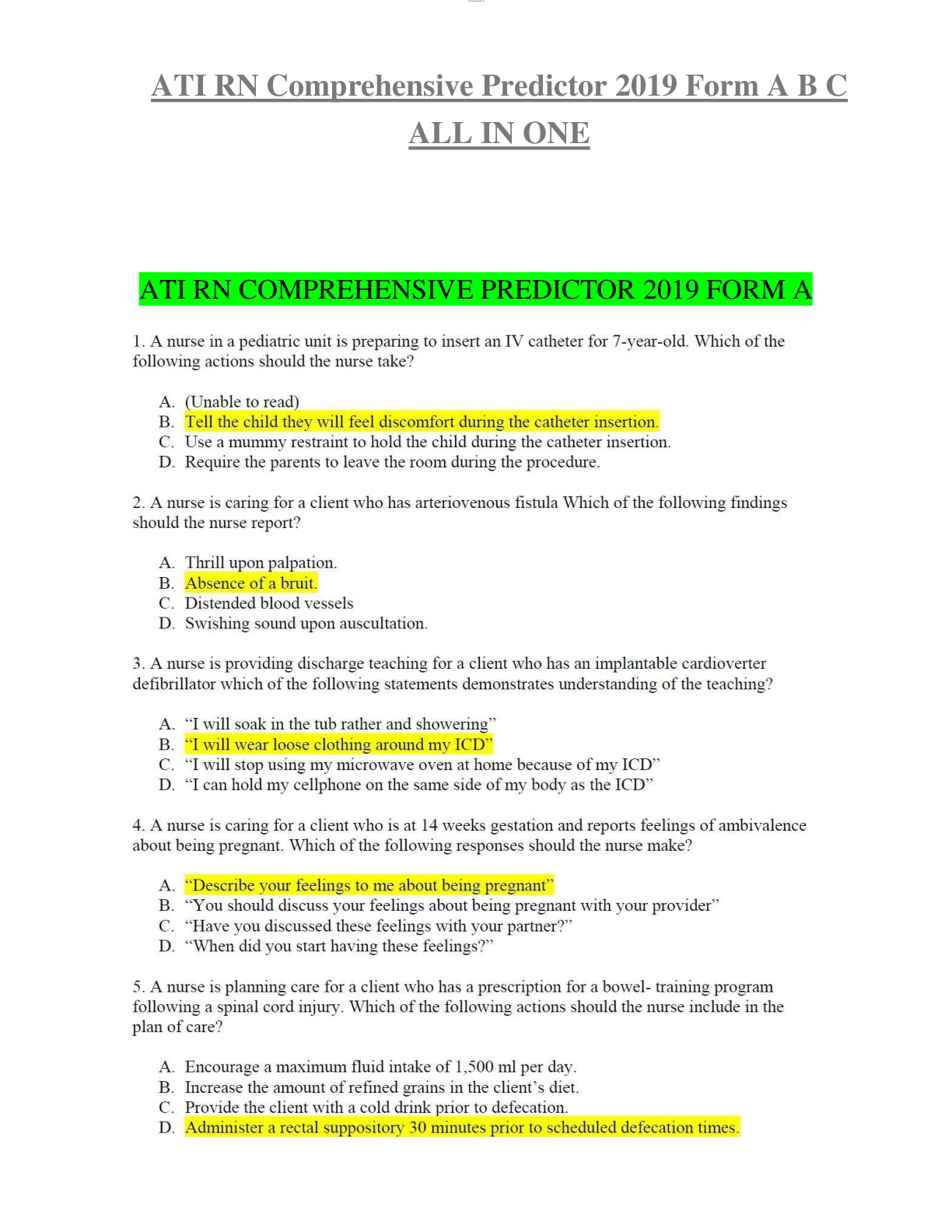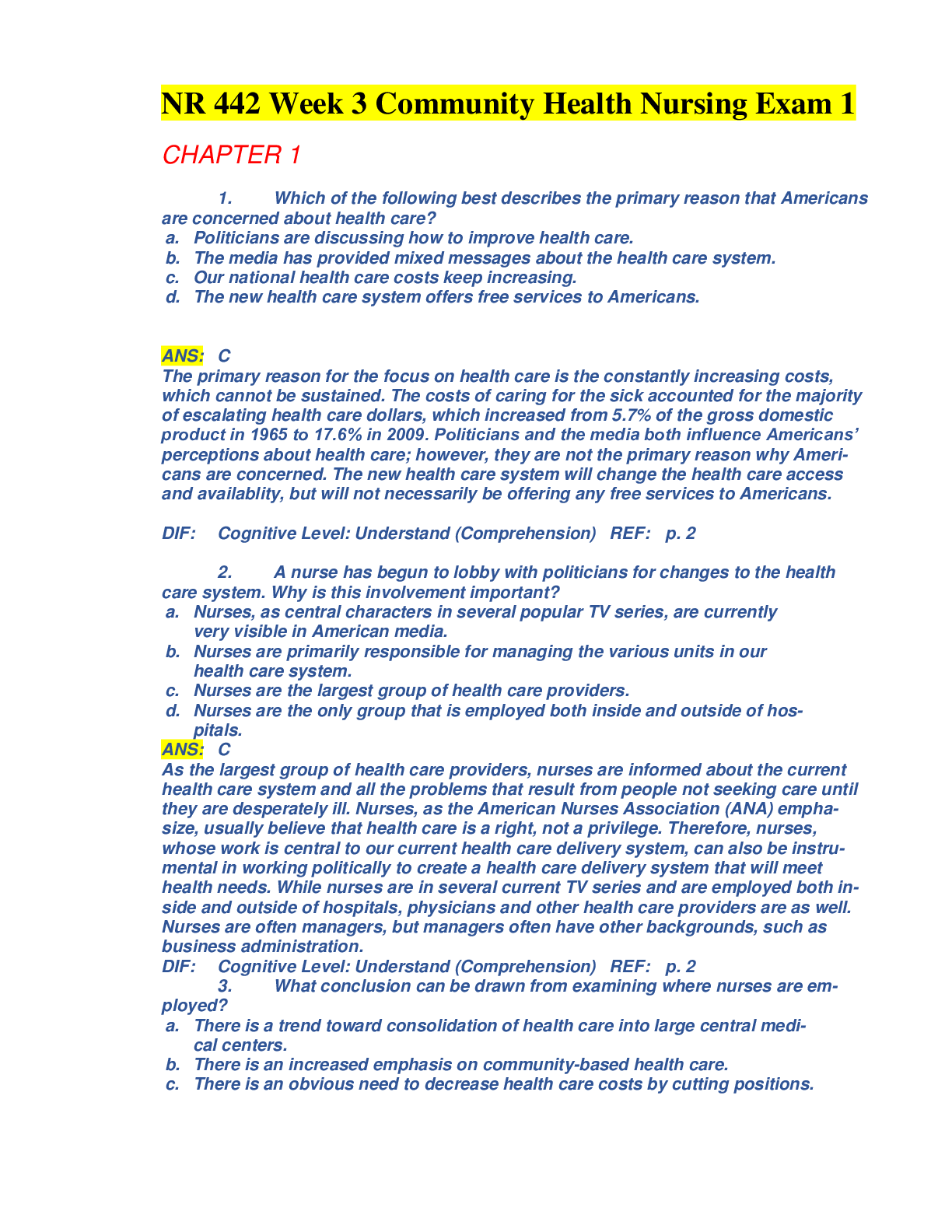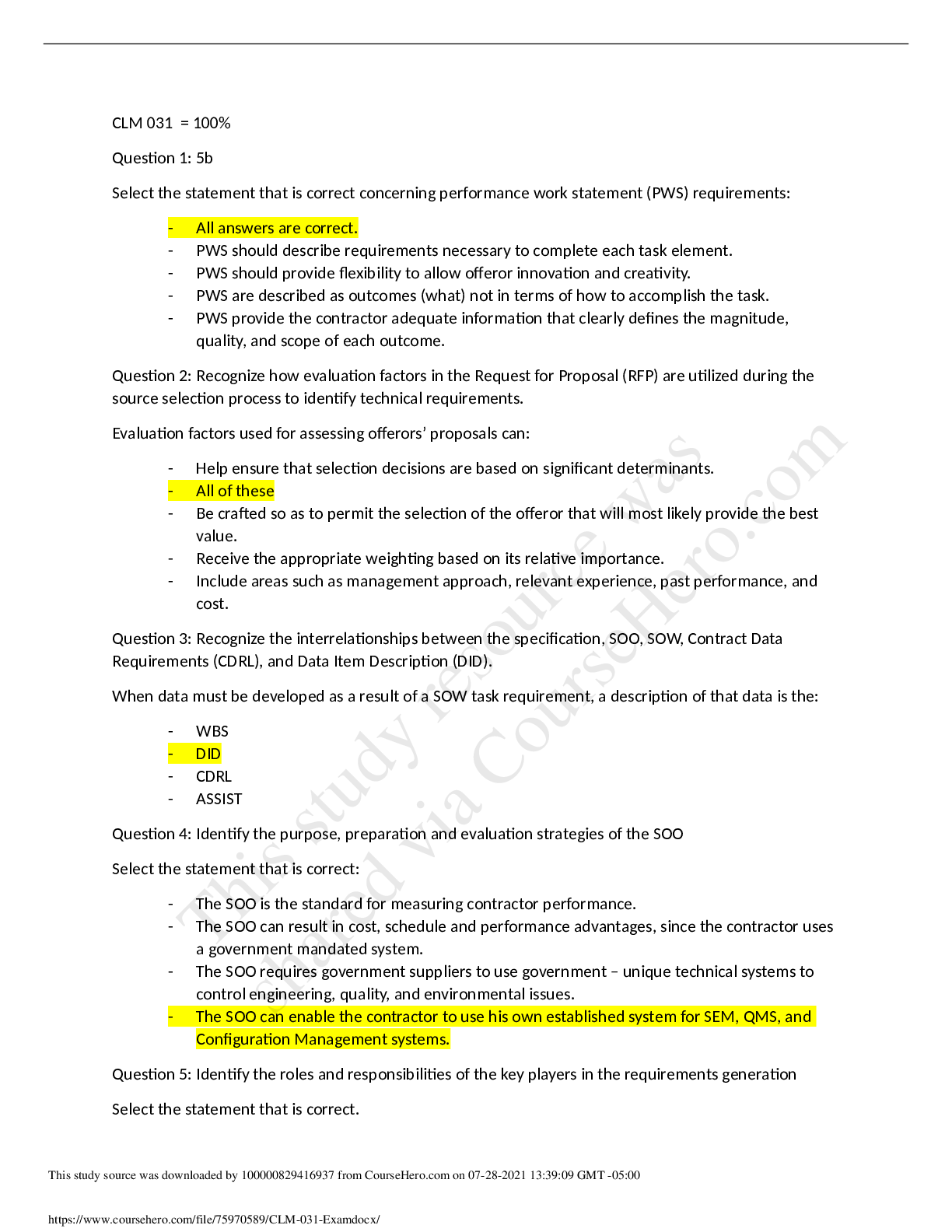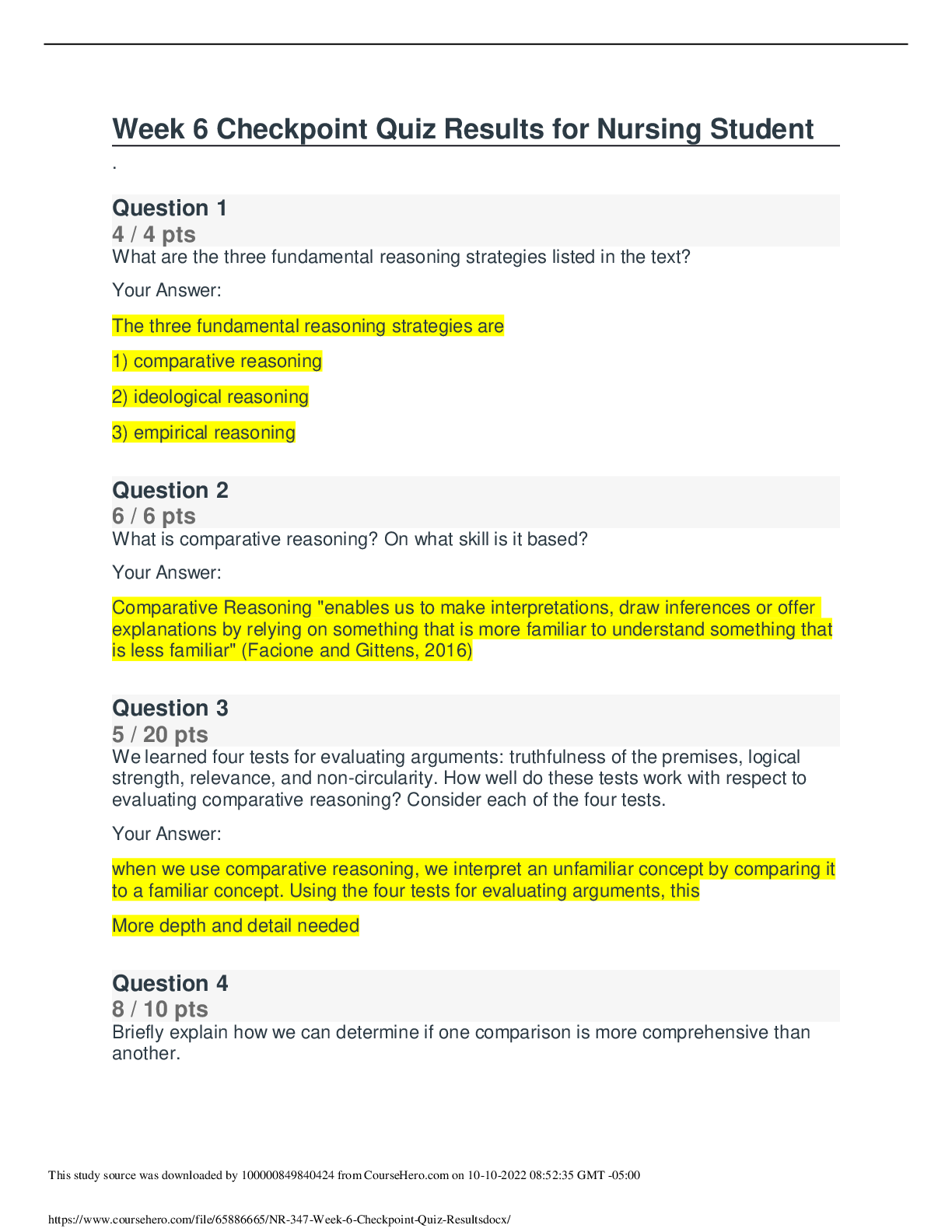Health Care > QUESTIONS & ANSWERS > VATI RN COMPREHENSIVE PREDICTOR FOCUSED REVIEW, Latest 2019/2020 (complete A+ guide) (All)
VATI RN COMPREHENSIVE PREDICTOR FOCUSED REVIEW, Latest 2019/2020 (complete A+ guide)
Document Content and Description Below
VATI RN COMPREHENSIVE PREDICTOR FOCUSED REVIEW Management of Care – (9) Advance Directives – (1) Legal Responsibilities: Purpose of a Living Will (RM FUND 9.0 Chp 4) • A living will ... is a legal document that expresses the client’s wishes regarding medical treatment in the event the client becomes incapacitated and is facing end-of-life issues. Most state laws include provisions that protect health care providers who follow a living will from liability. Assignment, Delegation and Supervision – (2) Delegation and Supervision: Delegating Tasks to an Assistive Personnel (RM FUND 9.0 Chp 6) • Examples of tasks nurses may delegate to Aps (provided the facility’s policy and state’s practice guidelines permit) • Activities of daily living (ADLs) – bathing, grooming, dressing, toileting, ambulating, feeding (without swallowing precautions), positioning • Routine tasks – bed making, specimen collection, intake and output, vital signs (for stable clients) Managing Client Care: Delegation Strategy for Effective Task Management (RM Leadership 7.0 Chp 1) • Consideration for selection of an appropriate delegate include the following: education, training, and experience; knowledge and skill to perform the task; level of critical thinking required to complete the task; ability to communicate with others as it pertains to the task; demonstrated competence; the delegatee’s culture; agency policies and procedures and licensing legislation (state nurse practice acts) Case Management – (1) Cardiovascular Disorders: Tetralogy of Fallot (RM NCC RN 10.0 Chp 20) • Tetralogy of Fallot – four defects that result in mixed blood flow: Pulmonary stenosis, ventricular septal defect, overriding aorta, right ventricular hypertrophy • Cyanosis at birth: progressive cyanosis over the first year of life. Systolic murmur. Episodes of acute cyanosis and hypoxia (blue or “Tet” spells) • Surgical procedures – shunt placement until able to undergo primary repair; complete repair within the first year of life Collaboration with Interdisciplinary Team – (1) Communicable Diseases, Disasters, and Bioterrorism: CDC Reportable Diagnoses (RM CH RN 7.0 Chp 6) • Anthrax. Botulism. Cholera. Congenital rubella syndrome (CRS). Diphtheria. Giardiasis. Gonorrhea. Hepatitis A, B, C. HIV infection. Influenza associated pediatric mortality. Legionellosis/Legionnaires’ disease. Lyme disease. Malaria. Meningococcal disease. Mumps. Pertussis (whooping cough). Poliomyelitis, paralytic. Poliovirus infection, nonparalytic. Rabies (human or animal). Rubella (German measles). Salmonellosis. Severe acute respiratory syndrome associated coronavirus disease (SARS CoV). Shigellosis. Smallpox. Syphilis. Tetanus/C. tetani. Toxic shock syndrome (TSS) (other than Streptococcal). Tuberculosis (TB). Typhoid fever. Vancomycin intermediate and vancomycin resistant. Staphylococcus aureus (VISA/VRSA) Continuity of Care – (1) Information Technology: Change-of-Shift Report (RM FUND 9.0 Chp 5) • Nurses give this report at the conclusion of each shift to the nurse assuming responsibility for the clients. • Formats include face to face, audiotaping, or presentation during walking rounds in each client’s room (unless the client has a roommate or visitors are present) • An effective report should: include significant objective information about the client’s health problems; proceed in a logical sequence; include no gossip or personal opinion; relate recent changes in medications, treatments, procedures, and the discharge plan Establishing Priorities – (1) Managing Client Care: Determining Priority Care for a Group of Clients (RM Leadership 7.0 Chp 1) • Prioritize systemic before local (“life before limb”) • Prioritizing interventions for a client in shock over interventions for a client who has a localized limb injury • Prioritize acute (less opportunity for physical adaptation) before chronic (greater opportunity for physical adaptation) • Prioritizing the care of a client who has a new injury/illness (e.g. mental confusion, chest pain) or an acute exacerbation of a previous illness over the care of a client who has a long-term chronic illness • Prioritize actual problems before potential future problems • Prioritizing administration of medication to a client experiencing of medication to a client experiencing acute pain over ambulation of a client at risk for thrombophlebitis • Listen carefully to clients and don’t assume • Asking a client who has a new diagnosis of diabetes mellitus what he feels is most important to learn about disease management • Recognize and respond to trends vs. transient findings • Recognizing a gradual deterioration in a client’s level of consciousness and/or Glasgow Coma Scale score • Recognize indications of medical emergencies and complications vs. expected findings • Recognizing indications of increasing intracranial pressure in a client who has a new diagnosis of a stroke vs. the findings expected following a stroke • Apply clinical knowledge to procedural standards to determine the priority action • Recognizing that the timing of administration of antidiabetic and antimicrobial medications is more important than administration of some other medications Ethical Practice – (1) Professional Responsibilities: Demonstration of Veracity (RM Leadership 7.0 Chp 3) • Veracity: the nurse’s duty to tell the truth Legal Rights and Responsibilities – (1) Professional Responsibilities: Rights of Clients (RM Leadership 7.0 Chp 3) • Client rights are the legal guarantees that clients have with regard to their health care • Clients using the services of a health care institution retain their rights as individuals and citizens of the United States. The America Hospital Association (AHA) identifies client rights in health care settings in the Patient Care Partnership () • Residents in nursing facilities that participate in Medicare programs similarly retain resident rights under statutes that govern the operation of these facilities • Nurse are accountable for protecting the rights of clients. Situations that require particular attention include informed consent, refusal of treatment, advance directives, confidentiality, and information security. Safety and Infection Control – (5) Accident/Error/Injury Prevention – (2) Medications Affecting Urinary Output: Indications for the Use of a Diuretic (RM Pharm RN 7.0 Chp 19) • High-ceiling loop diuretics work in the ascending limb of loop of Henle – block reabsorption of sodium and chloride and prevent reabsorption of water. Causes extensive diuresis even with severe renal impairment • They are used when there is an emergent need for rapid mobilization of fluid – pulmonary edema caused by heart failure; conditions not responsive to other diuretics, such as edema caused by liver, cardiac, or kidney disease; or hypertension • Unlabeled use – hypercalcemia Seizures: Maintaining Seizure Precautions (RM NCC RN 10.0 Chp 13) • Seizure precautions for any child at risk – pad side rails of bed, crib, and wheelchair; keep bed free of objects that could cause injury; have suction and oxygen equipment available Handling Hazardous and Infectious Materials – (1) Cancer Treatment Options: Implanted Internal Radiation Device (RM AMS RN 10.0 Chp 91) • Brachytherapy describes internal radiation that is placed close to the target tissue. This is done via placement in a body orifice (vagina) or body cavity (abdomen) or delivered via IV such as with radionuclide iodine, which is absorbed by the thyroid • Brachytherapy provides radiation to the tumor and a limited amount to surrounding normal tissues. Waste products are radioactive until the Isotope has been completely eliminated from the body. Waste products should not be touched by anyone. • Nursing Considerations • Place the client in a private room away from other clients when possible. Keep door closed as much as possible. Place a sign on the door warning of the radiation source. Wear a dosimeter film badge that records personal amount of radiation exposure. Limit visitors to 30-min visits, and have visitors maintain a distance of 6 feet from the source. Visitors and health care personnel who are pregnant or under the age of 18 should not come into contact with the client or radiation source. Weal a lead apron while providing care keeping the front of the apron facing the source of radiation. Keep a lead container in the client’s room if the delivery method could allow spontaneous loss of radioactive material. Tongs are available for placing radioactive material into this container. Follow protocol for proper removal of dressings and bed linens from the room. • Client Education • Inform the client of the need to remain in an indicated position to prevent dislodgement of the radiation implant. Instruct the client to call the nurse for assistance with elimination. Instruct the client and family about radiation precautions needed in health care and home environments. Standard Precautions/Transmission-Based Precautions/Surgical Asepsis – (2) Acute Neurological Disorders: Priority Intervention for Meningitis (RM NCC RN 10.0 Chp 12) • The presence of petechiae or a purpuric-type rash requires immediate medical attention • Isolate the client as soon as meningitis is suspected, and maintain droplet precautions per facility protocol – droplet precautions require a private room or a room with clients who have the same infectious disease, ensuring that each client has his or her own designated equipment. Providers and visitors should wear a mask. Maintain respiratory isolation for a minimum of 24 hr after initiation of antibiotic therapy • Monitor vital signs, urine output, fluid status, pain level, and neurologic status • For newborns and infants, monitor head circumference and fontanels for presence of or changes in bulging • Correct fluid volume deficits and then restrict fluids until no evidence of increased ICP and serum sodium levels are within the expected range • Maintain NPO status if the client has a decreased level of consciousness. As the client’s condition improves, advance to clear liquids and then a diet the client can tolerate • Decrease environmental stimuli – provide a quiet environment; minimize exposure to bright light (natural and electric) • Provide comfort measures – keep the room cool; position the client without a pillow, and slightly elevate the head of the bed. The client can also be positioned side-lying to reduce neck discomfort • Maintain safety (keep the bed in a low position, implement seizure precautions) • Keep the family informed of the client’s condition Skin Infections and Infestations: Expected Findings of Pediculosis Capitis (RM NCC RN 10.0 Chp 30) • Manifestations – intense itching; small, red bumps on the scalp; nits (white specks) on the hair shaft • Nursing interventions – 1% permethrin shampoo; Spinosad 0.9% topical suspension; Remove nits with a nit comb, repeat in 7 days after shampoo treatment; wash clothing, bedding in hot water with detergent; difficult cases; use malathion 0.5% Health Promotion and Maintenance – (2) Health Promotion/Disease Prevention – (2) Hepatitis and Cirrhosis: Client Teaching About Viral Hepatitis (RM AMS RN 10.0 Chp 55) • Viral hepatitis is the most common type of hepatitis. After exposure to a virus or toxin, the liver becomes enlarged from the inflammatory process. As the disease progresses, there is an increase in inflammation and necrosis, interfering with blood flow to the liver. Individuals can be infected with hepatitis and remain free of manifestations, and therefore are unaware that they could be contagious. • Nursing Care – most clients will be cared for in the home unless they are acutely ill. Enforce contact precautions if indicated. Provide a high-carbohydrate, high-calorie, low- to moderate-fat, and low- to moderate-protein diet, and small, frequent meals to promote nutrition and healing. Promote hepatic rest and the regeneration of tissue (administer only necessary medications; avoid over-the-counter medications or herbal supplements; avoid alcohol; limit physical activity). Educate the client and family regarding measures to prevent the transmission of the disease to others at home (avoid sexual intercourse until hepatitis antibody testing is negative; use proper hand hygiene). Provide culturally sensitive care. Immunizations: Recommendation for Older Adults (RM AMS RN 10.0 Chp 85) • Td booster. MMR vaccine. Varicella vaccine. Pneumococcal vaccine. Hepatitis A. Hepatitis B. Influenza vaccine. Meningococcal polysaccharide vaccine (MPSV4) and Meningococcal 4-valent conjugate (MenACWY) vaccine. Human Papilloma virus HPV2, HPV4, or HPV9. Zoster vaccine Psychosocial Integrity – (5) Abuse/Neglect – (1) Family Violence: Evaluating Child Abuse (RM MH RN 10.0 Chp 32) • Infants – shaken baby syndrome: shaking can cause intracranial hemorrhage. Assess for respiratory distress, bulging fontanels, and an increase in head circumference. Retinal hemorrhage can be present. Any bruising on an infant before age 6 months is suspicious. • Preschoolers to Adolescents – assess for unusual bruising, such as on abdomen, back or buttocks. Bruising is common on arms and legs in these age groups. Assess the mechanism of injury, which might not be congruent with the physical appearance of the injury. Numerous bruises at different stages of healing can indicate ongoing bearings. Be suspicious of bruises or welts that resemble the shape of a belt buckle or other object. Assess for burns. Burns covering “glove” or “stocking” areas of the hands or feet can indicate forced immersion into boiling water. Small, round burns can be from cigarettes. Assess for fractures with unusual features, such as forearm spiral fractures, which could be a result of twisting the extremity forcefully. The presence of multiple fractures is suspicious. Assess for human bite marks. Assess for head injuries, level of consciousness, equal and reactive pupils, and nausea or vomiting. Mental Health Concepts – (2) Anxiety Disorders: Expected Findings for a Client who has Social Anxiety Disorder (RM MH RN 10.0 Chp 11) • Social anxiety disorder (social phobia) – the client experiences excessive fear of social or performance situations • The client reports difficulty performing or speaking in front of others or participating in social situations due to an excessive fear of embarrassment or poor performance • The client might report physical manifestations (actual or factitious) in an attempt to avoid the social situation or need to perform Personality Disorders: Antisocial Personality Manifestations (RM MH RN 10.0 Chp 16) • Antisocial – characterized by disregard for others with exploitation, lack of empathy, repeated unlawful actions, deceit, and failure to accept personal responsibility; sense of entitlement, manipulative, impulsive, and seductive, nonadherence to traditional morals and values; verbally charming and engaging Support Systems – (1) Neurocognitive Disorders: Planning Care for a Stage 2 Alzheimer’s Disease (RM MH RN 10.0 Chp 17) • Stage 2: Moderate • Forgetting events of one’s own history. Difficulty performing tasks that require planning and organizing (paying bills, managing money). Difficulty with complex mental arithmetic. Personality and behavioral changes: appearing withdrawn or subdued, especially in social or mentally challenging situations; compulsive, repetitive actions. Changes in sleep patterns. Can wander and get lost. Can be incontinent. Clinical findings that are noticeable to others. • Nursing Care • Perform self-assessment regarding possible feelings of frustration, anger, or fear when performing daily care for clients who have progressive cognitive decline. Nursing interventions are focused on protecting the client from injury, (continues..................) [Show More]
Last updated: 1 year ago
Preview 1 out of 17 pages
.png)
Also available in bundle (3)

ATI RN ALL FILES (BUNDLE)
ATI RN ALL FILES (BUNDLE)////ATI RN ALL FILES (BUNDLE)/////ATI RN ALL FILES (BUNDLE)
By Rixx Dennis 2 years ago
$70
38

Ati Rn Comprehensive Exams( All in One) Bundle
Ati Rn Comprehensive Exams( All in One) Bundle////Ati Rn Comprehensive Exams( All in One) Bundle
By Rixx Dennis 1 year ago
$70
35

Ati Rn comprehensive Exams Files (ALL FILES)
Ati Rn comprehensive Exam////Ati Rn comprehensive Exams
By Rixx Dennis 1 year ago
$60.5
17
Reviews( 0 )
Recommended For You
*NURSING> QUESTIONS & ANSWERS > VATI RN 2ND COMPREHENSIVE PREDICTOR FOCUSED REVIEW NEW EXAM REVIEW DOCS 2021 (All)

VATI RN 2ND COMPREHENSIVE PREDICTOR FOCUSED REVIEW NEW EXAM REVIEW DOCS 2021
VATI RN 2ND COMPREHENSIVE PREDICTOR FOCUSED REVIEW NEW EXAM REVIEW DOCS 2021
By YongSam , Uploaded: Feb 07, 2021
$12.5
*NURSING> QUESTIONS & ANSWERS > NR 442 Week 3 Community Health Nursing Exam 1 (complete A+ Guide) (All)

NR 442 Week 3 Community Health Nursing Exam 1 (complete A+ Guide)
NR 442 Week 3 Community Health Nursing Exam 1 Chapter 1: Health: A Community View 1. Which of the following best describes the primary reason that Americans are concerned about health care? 2....
By Expert#1 , Uploaded: Apr 04, 2020
$13
*NURSING> QUESTIONS & ANSWERS > NCSBN TEST BANK for the NCLEX-RN & NCLEX-PN. Contains More than 2000 Q&A Plus Review and Rationale in 517 PAGES. (All)

NCSBN TEST BANK for the NCLEX-RN & NCLEX-PN. Contains More than 2000 Q&A Plus Review and Rationale in 517 PAGES.
NCSBN TEST BANK -for the NCLEX-RN & NCLEX-PN. Updated 2022/2023. Contains More than 2000 Q&A Plus Review and Rationale in 517 PAGES. (All Testable Questions for NCLEX-RN & NCLEX-PN)
By Expert1 , Uploaded: Jul 28, 2020
$20
Business> QUESTIONS & ANSWERS > CLM 031 EXAM (All)

CLM 031 EXAM
CLM 031 = 100% Question 1: 5b Select the statement that is correct concerning performance work statement (PWS) requirements: - All answers are correct. - PWS should describe requirements necessary...
By Book Worm, Certified , Uploaded: Nov 03, 2022
$5
*NURSING> QUESTIONS & ANSWERS > PHIL 347 Week 6 Checkpoint Quiz. Score 100/100 (All)

PHIL 347 Week 6 Checkpoint Quiz. Score 100/100
Question: What are the three fundamental reasoning strategies listed in the text? Question: What is comparative reasoning? On what skill is it based? Question: We learned four tests for evaluating...
By Amanda Rosales , Uploaded: Mar 24, 2021
$7
Business> QUESTIONS & ANSWERS > BUSINESS 1007 (All)

BUSINESS 1007
BUSINESS 1007 07 Key 1. (p. 178) Managers utilize organizational resources such as employees, information, and equipment to accomplish goals. 2. (p. 178) The main job of managers today is to w...
By Kirsch , Uploaded: Oct 19, 2019
$6
Anthropology> QUESTIONS & ANSWERS > KOR 352 FA19 101 week 8 Quiz. Already Graded A (All)

KOR 352 FA19 101 week 8 Quiz. Already Graded A
KOR 352 FA19 101: Week 8 Quiz Question 1 (0.25 points) Which of the following is not true of Kim and Finch’s observations during their field research in South Korea from 1997 to 2000? Question 1 o...
By Kirsch , Uploaded: Oct 17, 2019
$9
E-Commerce> QUESTIONS & ANSWERS > ESOC 316 Digital Commerce - University Of Arizona. Midterm Quiz. 20 Q&A. 100% Score (All)

ESOC 316 Digital Commerce - University Of Arizona. Midterm Quiz. 20 Q&A. 100% Score
ESOC 316 Digital Commerce - University Of Arizona. Midterm Quiz. 20 Q&A. 100% Score ESOC316 MIDTERM QUIZQuestion 6 (1 point) Saved Information has several properties that make information goods...
By Kirsch , Uploaded: Oct 15, 2019
$9.5
Marketing> QUESTIONS & ANSWERS > Marketing Management Chapter 2 to Chapter 10 Q&A (All)

Marketing Management Chapter 2 to Chapter 10 Q&A
Chapter 2 to Chapter 10 Chapter 2: Developing Marketing Strategies and Plans GENERAL CONCEPT QUESTIONS Multiple Choice 66 Chapter 1: Marketing: Managing Profitable Customer Relationships...
By Kirsch , Uploaded: Oct 14, 2019
$10
Marketing> QUESTIONS & ANSWERS > MKT 530 Customer Relationship Management. 155 Questions and Answers (All)

MKT 530 Customer Relationship Management. 155 Questions and Answers
MKT 530 All Questions and Answers MULTIPLE CHOICE. Choose the one alternative that best completes the statement or answers the question. 1) As the manager of an organization that is att...
By Kirsch , Uploaded: Oct 14, 2019
$10
Document information
Connected school, study & course
About the document
Uploaded On
Dec 15, 2020
Number of pages
17
Written in
Additional information
This document has been written for:
Uploaded
Dec 15, 2020
Downloads
0
Views
148






